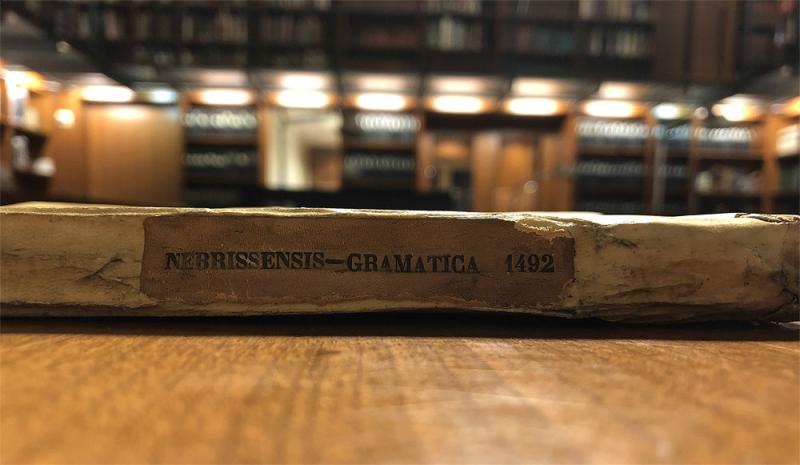This is a guest post by Armando Chávez-Rivera, Scholar in Residence at the Kluge Center, Library of Congress.
In my research, I try to understand important books written in the American hemisphere and inspired by canonical works of the Spanish language and literature from Spain. Therefore, it has been a pleasant surprise to realize that the Morgan Library & Museum has incunabula of Elio Antonio de Nebrija (1444–1522), which have been fundamental for the study of Latin and Spanish for half a millennium. Much has been written about Nebrija, his contributions as a philologist, Latinist, and lexicographer; his work at the universities of Salamanca and Alcalá; and the support provided to him by the Spanish monarchy and other influential figures of that era. Consequently, I am not going to reveal something totally new, but I do want to highlight the value of two Nebrija’s incunabula in the Morgan collection: Introductiones Latinae (1486) and Grammatica Antonii Nebrissensis [Gramática de la lengua castellana] (1492).
I start with Grammatica, which is often mentioned, but was printed only once during the author’s life. The second edition was published more than two centuries later, in the mid eighteenth century. Despite the fact that Grammatica is an obligatory reference today as a foundational milestone for the study of Spanish, in its time it attracted little attention. In the fifteenth century, people did not see the value of writing a grammar of a living language. They believed that learning by speaking was adequate. Nebrija made exceptional contributions to the then growing prestige of Castilian. He established grammatical and orthographic rules, polished and refined the lexicon, and harmonized graphemes to phonemes, improving the linkage between the written representation of the vowels and consonants with sounds.
That foundational grammar work was made known to Queen Isabella I of Castile in the summer of 1492, when Christopher Columbus had gone to sea on an uncertain journey. At that time, no one could predict the coming importance of the language spoken in Castile, due to the consolidation of the monarchy on the Iberian Peninsula and Spain’s imminent conquest and colonization of immense unknown territories. Significantly, Nebrija anticipated this approaching future in his introduction of Grammatica. He explained the importance of fostering a language that would be spoken in each region of the empire, as the Romans had done. Roman strength went hand in hand with the expansion of Latin into new territories and populations. In 160 pages, Nebrija explained how to use the language accurately. In addition, for those who were not native speakers, he included a section with instructions for learning Spanish.
Everything I have recounted about Grammatica greatly illuminates Nebrija’s sagacity as a philologist and educator. His works were born of his decade in Italy absorbing the legacy of classical Italian antiquity, which led to a desire to facilitate learning of the Latin language. Upon returning to Spain, he pledged to modernize teaching in the medieval classrooms of the Universidad de Salamanca. That same vision is what articulates Introductiones Latinae, one of the most famous Nebrija works in Europe and republished almost a hundred times in the New World. For this Latin grammar, he started with original classical sources and then eliminated corrupting voices. It is a work that breaks with the medieval tendency to base grammars on dark structures, long elucubrations, and an excessive accumulation of citations.

ChL 1739, Gramatica castellana by Antonio de Nebrija, ca. 1492 [spine]
With Introductiones Latinae, Nebrija opened the door for the rereading of the classics and the emerging Spanish literary renaissance. The first edition was published in 1481. The 1486 edition includes an introduction in Spanish inspired by Queen Isabella, who believed nuns should have a means by which they could learn Latin themselves in convents without assistance from male professors. Subsequently, Nebrija published two complementary works: Lexicon hoc est Dictionarium ex sermone latino in hispaniensem [Latin-Spanish Dictionary] (1492) and Dictionarium ex hispaniense in latinum sermonem [Spanish-Latin Vocabulary] (1495), both innovations defining words concisely and including abbreviated grammatical information. Thus, we owe much in modern lexicography to Nebrija, a Renaissance intellectual, who was convinced that the lexicon was the path to knowledge and should be precisely defined to promote its proper use by the wider public.
Half a millennium ago, Nebrija imagined that he would be remembered in the future above all as the undisputed authority in teaching Latin. However, today he is often recognized for his exceptional initiative in writing the first grammar of a language spoken by 572 million people. It is exciting to contemplate the incunabula of Nebrija, printed shortly after the arrival of the printing press in the Iberian Peninsula: they are the fruit of humanist ideas, the root of the Spanish Renaissance, and the foundation of the Spanish Empire in the New World. These two grammars preserved in the Morgan Library & Museum attest the close and strong ties between language and power throughout history.
 Armando Chávez-Rivera earned a PhD in Hispanic literature from the University of Arizona and is currently Associate Professor and Director of the Spanish Program at the University of Houston-Victoria, Texas. He earned a master’s degree in Hispanic Lexicography at the Royal Spanish Academy and University of León, Spain. He is a corresponding member of the North American Academy of the Spanish Language. He received fellowships for scholarly research from the New York Public Library and the Harry Ransom Center at the University of Texas at Austin. His academic research is concentrated on Cuban and Spanish-American culture, literature, and lexicography. He is currently a Scholar in Residence at the Kluge Center, Library of Congress.
Armando Chávez-Rivera earned a PhD in Hispanic literature from the University of Arizona and is currently Associate Professor and Director of the Spanish Program at the University of Houston-Victoria, Texas. He earned a master’s degree in Hispanic Lexicography at the Royal Spanish Academy and University of León, Spain. He is a corresponding member of the North American Academy of the Spanish Language. He received fellowships for scholarly research from the New York Public Library and the Harry Ransom Center at the University of Texas at Austin. His academic research is concentrated on Cuban and Spanish-American culture, literature, and lexicography. He is currently a Scholar in Residence at the Kluge Center, Library of Congress.

